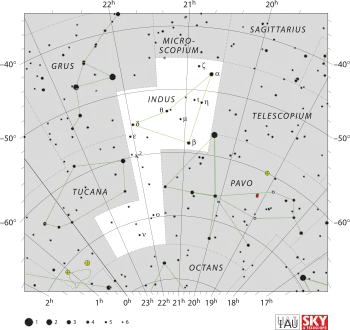| Constellation | |
 | |
| Abbreviation | Ind |
|---|---|
| Genitive | Indi |
| Pronunciation | /ˈɪndʊs/, genitive /ˈɪndaɪ/ |
| Symbolism | the Indian[1] |
| Right ascension | 20h 28m 40.6308s–23h 27m 59.4799s[2] |
| Declination | −44.9588585°–−74.4544678°[2] |
| Quadrant | SQ4 |
| Area | 294 sq. deg. (49th) |
| Main stars | 3 |
| Bayer/Flamsteed stars | 16 |
| Stars with planets | 3 |
| Stars brighter than 3.00m | 0 |
| Stars within 10.00 pc (32.62 ly) | 1 |
| Brightest star | The Persian (α Ind) (3.11m) |
| Messier objects | none |
| Meteor showers | none[3] |
| Bordering constellations | Microscopium Sagittarius (corner) Telescopium Pavo Octans Tucana Grus |
| Visible at latitudes between +15° and −90°. Best visible at 21:00 (9 p.m.) during the month of September. | |
Indus is a constellation in the southern sky first professionally surveyed by Europeans in the 1590s and mapped on a globe by Petrus Plancius by early 1598. It was included on a plate illustrating southern constellations in Bayer's sky atlas Uranometria in 1603. It lies well south of the Tropic of Capricorn but its triangular shape can be seen for most of the year from the Equator. It is elongated from north to south and has a complex boundary. The English translation of its name is generally given as the Indian, though it is unclear which indigenous people the constellation was originally supposed to represent.
Features

Indus lacks stars of the top 100 in brightness viewed from the solar system (apparent magnitude). Two of its stars rank of third magnitude and three of fourth magnitude.
Bright stars
Alpha Indi, its brightest, is an orange giant of magnitude 3.1, 101 light-years away. Beta Indi is an orange giant of magnitude 3.7, 600 light-years distant. Delta Indi is a white star of magnitude 4.4, 185 light-years from Earth. The three form a near-perfect right-angled triangle, such that Beta marks the right angle and is in the south-east.
Epsilon Indi is one of the closest stars to Earth, approximately 11.8 light years away. It is an orange dwarf of magnitude 4.7, meaning that the yellow dwarf Sun is slightly hotter and larger.[4] The system has been discovered to contain a pair of binary brown dwarfs, and has long been a prime candidate in SETI studies.[5][6] This star has the third-highest proper motion of all visible to the unaided eye, as ranks behind Groombridge 1830 and 61 Cygni, and the ninth-highest overall. This will move the star into Tucana around 2640. It figures directly between Alpha and Beta.
Indus is home to one bright binary star. Theta Indi is a binary star divisible in small amateur telescopes, 97 light-years from Earth. Its primary is a white star of magnitude 4.5 and its secondary is a white star of magnitude 7.0.[4] It figures close to the hypotenuse of the right-angled triangle of Alpha, Beta and Delta, the three brightest stars of Indus.
Variable stars
T Indi is the only bright variable star in Indus. It is a semi-regular, deeply coloured red giant with a period of 11 months, 1900 light-years away. Its minimum magnitude is 7 and its maximum: 5.[4]
Galaxies
Galaxies include NGC 7038, NGC 7049, and NGC 7090.

Supernovae
All Sky Automated Survey for SuperNovae (ASAS-SN) in 2015 detected a superluminous supernova, named ASASSN-15lh (also designated SN 2015L[7]). Based on the study conducted by Subo Dong and team from the Kavli Institute for Astronomy and Astrophysics (KIAA) at Peking University, it was approximately doubly luminous to any supernova detected, and at peak was almost 50 times more intrinsically luminous than the Milky Way. Its distance: approximately 3.82 gigalight-years, denoting an age approximately half that of the universe.[8]
History

The constellation was created by Petrus Plancius who made a fairly large celestial globe from the observations of Pieter Dirkszoon Keyser and Frederick de Houtman.[4] The first depiction of this constellation in a celestial atlas followed in Johann Bayer's Uranometria of 1603.[9][10] Plancius portrayed the figure as a nude male with three arrows in one hand and one in the other, as a native, lacking quiver and bow.[11] It is among the twelve constellations introduced by Keyser and de Houtman, which first appeared on a celestial globe in 1598.
See also
References
- ↑ Sasaki, Chris (2003). Constellations: The Stars and Stories. ISBN 9781402708008.
- 1 2 IAU, The Constellations, Indus.
- ↑ Anonymous (February 3, 2007). "Meteor Showers". American Meteor Society. Retrieved 2008-05-07.
- 1 2 3 4 Ridpath & Tirion 2001, pp. 162–163.
- ↑ Burnham, Robert; Luft, Herbert A. (1978). Burnham's Celestial Handbook: An Observer's Guide to the Universe Beyond the Solar System. Courier Dover Publications. ISBN 0-486-23568-8.
- ↑ Lawton, A. T. (1975). "CETI from Copernicus". Spaceflight. 17: 328–330. Bibcode:1975SpFl...17..328L.
- ↑ Central Bureau for Astronomical Telegrams CBET 4120
- ↑ Carnegie Institution for Science (January 14, 2016). "Most-luminous supernova ever discovered". phys.org. Retrieved January 15, 2016.
- ↑ Bakich, Michael E. (1995). The Cambridge Guide to the Constellations. Cambridge University Press. ISBN 0-521-44921-9.
- ↑ Sawyer Hogg, Helen (1951). "Out of Old Books (Pieter Dircksz Keijser, Delineator of the Southern Constellations)". Journal of the Royal Astronomical Society of Canada. 45: 215. Bibcode:1951JRASC..45..215S.
- ↑ Allen, Richard Hinckley (1963). Star Names, Their Lore and Meaning. New York: Dover Publications. ISBN 0-486-21079-0.
Sources
- "Indus". The Constellations. International Astronomical Union.
- Ridpath, Ian; Tirion, Wil (2001), Stars and Planets Guide, Princeton University Press, ISBN 0-691-08913-2
- Ian Ridpath and Wil Tirion (2007). Stars and Planets Guide, Collins, London. ISBN 978-0-00-725120-9. Princeton University Press, Princeton. ISBN 978-0-691-13556-4.
External links
- The Deep Photographic Guide to the Constellations: Indus
- The clickable Indus
- Starry Night Photography: Indus Constellation
- Star Tales–Indus
 Media related to Indus (constellation) at Wikimedia Commons
Media related to Indus (constellation) at Wikimedia Commons